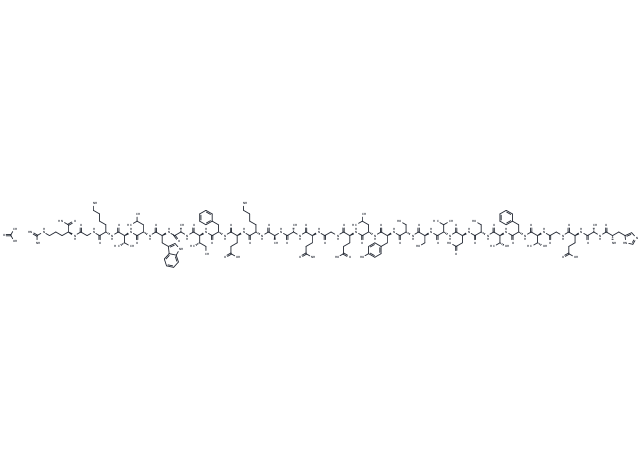Shopping Cart
- Remove All
 Your shopping cart is currently empty
Your shopping cart is currently empty

GLP-1(7-36), amide acetate is a derivative of GLP-1 peptide (glucagon-like peptide-1).GLP-1(7-36), amide is able to activate the GLP-1 receptor, which has the ability to promote insulin secretion and inhibit glucagon secretion, with the potential to treat type 2 diabetes mellitus and obesity.

| Pack Size | Price | Availability | Quantity |
|---|---|---|---|
| 500 μg | $119 | In Stock | |
| 1 mg | $198 | In Stock | |
| 5 mg | $594 | In Stock | |
| 10 mg | $945 | In Stock | |
| 25 mg | $1,670 | In Stock | |
| 50 mg | $2,250 | In Stock | |
| 100 mg | $2,970 | In Stock |
| Description | GLP-1(7-36), amide acetate is a derivative of GLP-1 peptide (glucagon-like peptide-1).GLP-1(7-36), amide is able to activate the GLP-1 receptor, which has the ability to promote insulin secretion and inhibit glucagon secretion, with the potential to treat type 2 diabetes mellitus and obesity. |
| In vitro | Cells exposed to phorbol 12-myristate 13-acetate for 2 hours exhibited significantly enhanced GLP-1(7-36) levels compared to untreated controls. Similarly, glucose exposure augmented GLP-1 secretion in a dose-responsive manner. Fatty acids, including palmitic, oleic, linoleic, and linolenic acids, also elevated GLP-1 secretion dose-dependently, with unsaturated fatty acids (oleic, linoleic, and linolenic acids) proving more potent than saturated palmitic acid. Furthermore, treatment with CPE on NCI-H716 cells led to a dose-dependent increase in GLP-1 levels, with a notable 37% rise at 0.1% CPE concentration[1]. |
| In vivo | Gastrointestinal administration of glucose increased active GLP-1(7-36), amide acetate levels in portal vein blood 10 minutes later, followed by a significant decrease in active GLP-1 levels 30 minutes later. TO active GLP-1 levels also increased 10 minutes after gastric administration, then decreased to basal levels at 60 minutes. [1] |
| Alias | Human GLP-1 (7-36), amide acetate, Glucagon-like peptide-1 (GLP-1)(7-36), amide acetate |
| Molecular Weight | 3357.68 |
| Formula | C151H230N40O47 |
| Cas No. | 1119517-19-9 |
| Smiles | C(C)(O)=O.C([C@@H](C(N[C@H](C(N[C@H](C(N[C@H](C(NCC(N[C@@H](CCCNC(=N)N)C(N)=O)=O)=O)CCCCN)=O)[C@@H](C)C)=O)CC(C)C)=O)NC([C@@H](NC([C@@H](NC([C@H](CC1=CC=CC=C1)NC([C@@H](NC([C@@H](NC([C@@H](NC([C@@H](NC([C@@H](NC(CNC([C@@H](NC([C@@H](NC([C@H](CC2=CC=C(O)C=C2)NC([C@@H](NC([C@@H](NC([C@@H](NC([C@@H](NC([C@@H](NC([C@@H](NC([C@H](CC3=CC=CC=C3)NC([C@@H](NC(CNC([C@@H](NC([C@@H](NC([C@H](CC4=CN=CN4)N)=O)C)=O)CCC(O)=O)=O)=O)[C@@H](C)O)=O)=O)[C@@H](C)O)=O)CO)=O)CC(O)=O)=O)C(C)C)=O)CO)=O)CO)=O)=O)CC(C)C)=O)CCC(O)=O)=O)=O)CCC(N)=O)=O)C)=O)C)=O)CCCCN)=O)CCC(O)=O)=O)=O)[C@H](CC)C)=O)C)=O)C=5C=6C(NC5)=CC=CC6 |
| Relative Density. | no data available |
| Storage | keep away from moisture | Powder: -20°C for 3 years | In solvent: -80°C for 1 year | Shipping with blue ice. | |||||||||||||||||||||||||
| Solubility Information | H2O: 80.00 mg/mL (23.83 mM), Sonication is recommended. | |||||||||||||||||||||||||
Solution Preparation Table | ||||||||||||||||||||||||||
H2O
| ||||||||||||||||||||||||||

Copyright © 2015-2025 TargetMol Chemicals Inc. All Rights Reserved.